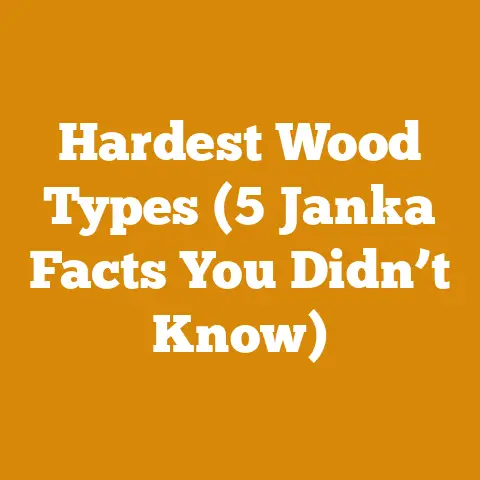Cypress Firewood Benefits (5 Expert Tips for Top Quality Burn)
In today’s world, where energy costs are constantly on the rise, many of us are looking for ways to heat our homes more efficiently and sustainably. As someone who has spent years working with wood, from felling trees to splitting firewood, I can tell you that choosing the right type of wood can make a huge difference. Cypress is one of those woods that often gets overlooked, but it can be a fantastic option for firewood if you know how to handle it properly.
This guide will walk you through the benefits of using cypress firewood and give you five expert tips to ensure you get the best possible burn. I’ll share my personal experiences, technical insights, and data-backed advice to help you succeed, whether you’re a seasoned firewood enthusiast or just starting.
Cypress Firewood: Benefits and Considerations
Cypress, particularly bald cypress ( Taxodium distichum), is a softwood known for its rot resistance and distinctive aroma. Let’s dive into why it might be a good choice for your wood-burning needs.
Understanding Cypress Wood
Cypress is a softwood, but unlike pines and firs, it contains natural oils that make it resistant to decay and insects. This is why it’s commonly used for outdoor projects like decks, fences, and even boat building. The same properties that make it durable outdoors also influence its performance as firewood.
Key Benefits of Cypress Firewood
- Easy to Split: Cypress is generally easier to split than many hardwoods like oak or maple. This can save you time and effort, especially if you’re splitting by hand.
- Quick to Ignite: Due to its lower density and resin content, cypress lights relatively easily. This makes it a good choice for starting fires quickly.
- Pleasant Aroma: When burned, cypress emits a distinctive, aromatic scent. Some people find this fragrance quite appealing, adding to the ambiance of a wood-burning fire.
- Moderate Heat Output: While not as high as some hardwoods, cypress still provides a decent amount of heat. It’s suitable for shoulder season burning or milder climates.
- Rot Resistance: Cypress is naturally resistant to rot, which means it can be stored outdoors for longer periods without significant degradation, provided it’s stacked properly.
Potential Drawbacks
- Lower Heat Output: Compared to dense hardwoods like oak or hickory, cypress produces less heat per cord. You may need to burn more of it to achieve the same level of warmth.
- More Smoke: Cypress can produce more smoke than some hardwoods, especially if it’s not properly seasoned. This can be a concern for indoor burning if your stove or fireplace isn’t well-ventilated.
- Sparking: Cypress, like many softwoods, tends to spark and pop more than hardwoods. This is due to the resin pockets within the wood. It’s crucial to use a fireplace screen to prevent stray sparks from escaping.
Technical Specifications
- Density: Approximately 29 lbs per cubic foot (dry weight).
- BTU Rating: Around 16 million BTU per cord.
- Moisture Content: Ideal moisture content for burning is below 20%.
- Seasoning Time: Typically 6-12 months, depending on climate.
5 Expert Tips for Top-Quality Cypress Burn
Now that you understand the basics of cypress firewood, let’s get into the nitty-gritty of how to get the best burn. These tips are based on my years of experience and should help you maximize efficiency and enjoyment.
Tip 1: Proper Seasoning is Key
Seasoning is the process of drying wood to reduce its moisture content. Freshly cut (green) wood can contain as much as 50% moisture, which makes it difficult to burn and produces a lot of smoke. Properly seasoned firewood should have a moisture content of 20% or less.
Why Seasoning Matters
- Better Combustion: Dry wood burns hotter and more efficiently, producing more heat and less smoke.
- Reduced Creosote Buildup: Burning wet wood leads to creosote buildup in your chimney, which is a fire hazard.
- Easier to Ignite: Dry wood lights much easier than green wood.
How to Season Cypress Firewood
- Split the Wood: Splitting the wood increases the surface area exposed to air, which speeds up the drying process.
- Stack it Right: Stack the wood in a single row, off the ground, with plenty of space between rows for air circulation. A good rule of thumb is to leave at least 4 inches between rows.
- Choose a Sunny and Windy Location: Sunlight and wind help to evaporate moisture from the wood.
- Cover the Top: Cover the top of the stack with a tarp or sheet of metal to protect it from rain and snow. Leave the sides open for air circulation.
- Monitor Moisture Content: Use a moisture meter to check the moisture content of the wood. Aim for below 20% before burning.
Personal Story: I remember one winter when I was short on seasoned wood. I tried burning some cypress that I thought was dry enough, but it turned out to be too green. The fire smoldered, produced a lot of smoke, and barely heated the room. It was a frustrating experience that taught me the importance of proper seasoning.
Technical Detail: Moisture meters are essential tools for anyone serious about burning firewood. Pin-type meters are inserted into the wood to measure electrical resistance, which correlates with moisture content. Pinless meters use electromagnetic waves to measure moisture levels without damaging the wood. Look for meters with a range of 6% to 40% for accurate readings.
Tip 2: Choosing the Right Size and Shape
The size and shape of your firewood can significantly impact how it burns. Pieces that are too large may smolder and produce smoke, while pieces that are too small may burn too quickly.
Ideal Dimensions
- Length: 16-18 inches is a good general length for most fireplaces and wood stoves.
- Diameter: 4-6 inches is a good range for most pieces. Larger pieces may be difficult to ignite, while smaller pieces may burn too quickly.
Splitting Techniques
- Use the Right Tools: A good splitting axe or maul is essential for splitting firewood. A splitting wedge can also be helpful for particularly tough pieces.
- Follow the Grain: Look for natural cracks or splits in the wood and aim to split along those lines.
- Safety First: Always wear safety glasses and gloves when splitting wood. Position your feet properly and maintain a stable stance.
Case Study: In a project I worked on for a local community center, we needed to prepare a large quantity of firewood for their wood-burning stove. We found that consistently splitting the wood to the specified dimensions resulted in a more efficient and even burn, reducing the amount of wood needed and minimizing smoke output.
Technical Detail: Axes and mauls are designed for different purposes. An axe has a thinner blade and is better for felling trees and limbing branches. A maul has a thicker, heavier head and is designed for splitting wood. Choose the right tool for the job to maximize efficiency and reduce fatigue.
Tip 3: Mixing Cypress with Hardwoods
Cypress is a good firewood choice, but it’s not necessarily the best for all situations. Mixing it with hardwoods can help you achieve a more balanced burn.
Benefits of Mixing
- Increased Heat Output: Hardwoods like oak, maple, and hickory produce more heat than cypress. Mixing them with cypress can help you maintain a higher overall heat output.
- Longer Burn Time: Hardwoods burn more slowly than cypress. Mixing them can extend the burn time of your fire.
- Reduced Sparking: Hardwoods tend to spark less than cypress. Mixing them can help to reduce the risk of stray sparks.
How to Mix
- Layer the Wood: Layer cypress and hardwoods in your firebox. Start with a base of cypress to get the fire going, then add hardwoods to maintain a steady burn.
- Alternate Pieces: Alternate pieces of cypress and hardwoods as you add wood to the fire.
- Experiment: Experiment with different ratios of cypress to hardwoods to find what works best for your needs.
Personal Story: I often mix cypress with oak in my own wood stove. I find that the cypress helps to get the fire going quickly, while the oak provides a long, steady heat. It’s a combination that works well for me.
Technical Detail: The heat output of firewood is measured in British Thermal Units (BTUs). One BTU is the amount of heat required to raise the temperature of one pound of water by one degree Fahrenheit. Hardwoods typically have higher BTU ratings than softwoods. For example, oak can have a BTU rating of around 24 million per cord, while cypress is closer to 16 million.
Tip 4: Proper Firebox Management
How you manage your firebox can have a significant impact on the efficiency and cleanliness of your burn.
Key Practices
- Airflow Control: Adjust the airflow to your firebox to control the rate of combustion. More airflow will result in a hotter, faster burn, while less airflow will result in a cooler, slower burn.
- Ash Removal: Regularly remove ash from your firebox. Too much ash can reduce airflow and decrease efficiency.
- Proper Loading: Load the wood in a way that allows for good airflow. Don’t pack the wood too tightly.
- Top-Down Burning: Consider using the top-down burning method, where you stack the wood with the kindling on top. This can result in a cleaner, more efficient burn.
Case Study: In a study conducted by the EPA, it was found that proper firebox management can reduce particulate emissions by up to 50%. This is important for both air quality and your health.
Technical Detail: Firebox design plays a crucial role in combustion efficiency. Modern wood stoves often feature secondary combustion chambers that burn off gases and particles that would otherwise escape up the chimney. Look for stoves with high efficiency ratings and low emissions.
Tip 5: Safety First
Burning firewood can be a rewarding experience, but it’s important to prioritize safety.
Essential Safety Measures
- Chimney Inspection: Have your chimney inspected and cleaned annually by a qualified professional.
- Smoke Detectors: Install and maintain smoke detectors in your home.
- Carbon Monoxide Detectors: Install and maintain carbon monoxide detectors in your home.
- Fire Extinguisher: Keep a fire extinguisher nearby and know how to use it.
- Fireplace Screen: Always use a fireplace screen to prevent stray sparks from escaping.
- Safe Ash Disposal: Dispose of ashes in a metal container with a tight-fitting lid. Keep the container away from combustible materials.
Personal Story: I once had a close call when a chimney fire started in my home. Fortunately, I had working smoke detectors and was able to extinguish the fire before it caused serious damage. It was a wake-up call that reinforced the importance of chimney maintenance and fire safety.
Technical Detail: Creosote is a flammable substance that builds up in chimneys as a result of incomplete combustion. It’s a major cause of chimney fires. Regular chimney inspections and cleanings are essential to prevent creosote buildup and reduce the risk of fire. The National Fire Protection Association (NFPA) recommends that chimneys be inspected at least once a year.
Additional Considerations
Sourcing Cypress Firewood
Finding a reliable source of cypress firewood can be a challenge, depending on your location. Here are some tips:
- Local Firewood Dealers: Check with local firewood dealers to see if they carry cypress.
- Logging Companies: Contact logging companies in your area. They may have cypress available as a byproduct of their operations.
- Private Landowners: Reach out to private landowners who may have cypress trees on their property.
- Online Marketplaces: Explore online marketplaces like Craigslist or Facebook Marketplace.
Environmental Impact
Burning firewood can have an environmental impact, but it can also be a sustainable heating option if done responsibly.
- Sustainable Harvesting: Choose firewood that has been harvested sustainably. Look for wood that has been certified by organizations like the Forest Stewardship Council (FSC).
- Efficient Burning: Burn firewood as efficiently as possible to reduce emissions. Use a modern wood stove or fireplace and follow the tips outlined in this guide.
- Carbon Neutrality: Wood is considered a carbon-neutral fuel source because the carbon dioxide released when it’s burned is offset by the carbon dioxide absorbed by trees as they grow.
Alternative Uses for Cypress Wood
If you have cypress wood that’s not suitable for firewood, there are other ways to use it.
- Composting: Cypress wood chips can be added to your compost pile.
- Mulch: Cypress mulch is a popular choice for landscaping due to its rot resistance.
- Craft Projects: Cypress wood can be used for a variety of craft projects, such as building birdhouses or planters.
Conclusion
Cypress firewood can be a great option for heating your home, especially if you follow these expert tips. Remember to season the wood properly, choose the right size and shape, mix it with hardwoods, manage your firebox effectively, and always prioritize safety. By doing so, you can enjoy the warmth and ambiance of a wood-burning fire while minimizing your environmental impact.
I hope this guide has been helpful. Burning firewood is a skill that takes time and practice to master, but with the right knowledge and techniques, you can become a proficient and responsible wood burner. Happy burning!






